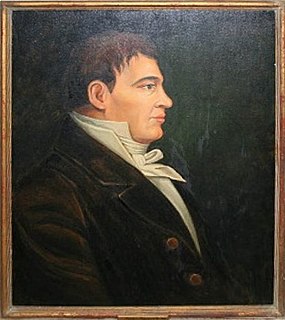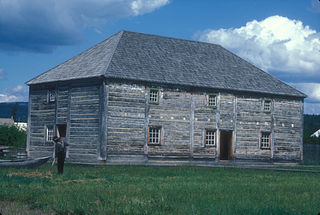
The North West Company was a fur trading business headquartered in Montreal from 1779 to 1821. It competed with increasing success against the Hudson's Bay Company in what is present-day Western Canada and Northwestern Ontario. With great wealth at stake, tensions between the companies increased to the point where several minor armed skirmishes broke out, and the two companies were forced by the British government to merge.

Simon Fraser was a fur trader and explorer of Scottish ancestry who charted much of what is now the Canadian province of British Columbia. He also built the first European settlement in British Columbia.

In the 19th century, the Oregon Country was a disputed region of the Pacific Northwest of North America. The region was occupied by British and French Canadian fur traders from before 1810, as well as American settlers from the mid-1830s, with its coastal areas north from the Columbia River frequented by ships from all nations engaged in the maritime fur trade, most of these from the 1790s through 1810s being Boston-based. The Oregon Treaty of 1846 ended disputed joint occupancy pursuant to the Treaty of 1818 and established the British-American boundary at the 49th parallel.

The Pacific Fur Company (PFC) was an American fur trade venture wholly owned and funded by John Jacob Astor that functioned from 1810 to 1813. It was based in the Pacific Northwest, an area contested over the decades between the United Kingdom of Great Britain and Ireland, the Spanish Empire, the United States of America and the Russian Empire.

Fort Astoria was the primary fur trading post of John Jacob Astor's Pacific Fur Company (PFC). A maritime contingent of PFC staff was sent on board the Tonquin, while another party traveled overland from St. Louis. This land based group later became known as the Astor Expedition. Built at the entrance of the Columbia River in 1811, Fort Astoria was the first American-owned settlement on the Pacific coast of North America.
New Caledonia was a fur-trading district of the Hudson's Bay Company that comprised the territory of the north-central portions of present-day British Columbia, Canada. Though not a British colony, New Caledonia was part of the British claim to North America. Its administrative centre was Fort St. James. The rest of what is now mainland British Columbia was called the Columbia Department by the British, and the Oregon Country by the Americans. Even before the partition of the Columbia Department by the Oregon Treaty in 1846, New Caledonia was often used to describe anywhere on the mainland not in the Columbia Department, such as Fort Langley in the Fraser Valley.

Stuart Lake, or Nak'albun in the Carrier (Dakelh) language is a lake situated in the Northern Interior of British Columbia, Canada. The town of Fort St. James is situated by the lake near the outlet. Stuart Lake is 66 kilometres (41 mi) long, 10 kilometres (6.2 mi) wide and relatively shallow, with an average depth of 26 metres (85 ft).

The Columbia District was a fur trading district in the Pacific Northwest region of British North America in the 19th century. Much of its territory overlapped with the disputed Oregon Country. It was explored by the North West Company between 1793 and 1811, and established as an operating fur district around 1810. The North West Company was absorbed into the Hudson's Bay Company in 1821 under which the Columbia District became known as the Columbia Department. The Oregon Treaty of 1846 marked the effective end of the Hudson's Bay Company's Columbia Department.

The Nechako River arises on the Nechako Plateau east of the Kitimat Ranges of the Coast Mountains of British Columbia, Canada, and flows north toward Fort Fraser, then east to Prince George where it enters the Fraser River. "Nechako" is an anglicization of netʃa koh, its name in the indigenous Carrier language which means "big river".

John Stuart was a 19th-century Scottish–Canadian explorer and fur trader. He was a partner in the North West Company and Chief Factor of the Hudson's Bay Company.
The Stuart River or Nak'alkoh is one of the largest tributaries of the Nechako River in northeastern British Columbia, Canada. The Nechako is in turn one the more important tributaries of the Fraser River. The Stuart River flows 187 kilometres (116 mi) from Stuart Lake to its junction with the Nechako River. The river drains a portion of the Nechako Plateau—a gently-rolling region characterized by small lakes and tributaries. Low but impressive ridges interact with the river, creating high bluffs and hoodoos.
Samuel Black was a Scottish fur trader and explorer, a clerk in the New North Nest Company (XYC) and Wintering Partner in the North West Company (NWC), and later clerk, chief trader, and chief factor in the Hudson's Bay Company (HBC) for the Columbia District. In 1824, he explored the Finlay River and its tributaries in present-day north-central British Columbia, Canada, including the Muskwa, Omineca and Stikine for the HBC. His journals were published by the Hudson's Bay Record Society in 1955.
John McLeod was a Scottish-born explorer of Canada, in his capacity as a fur trader with the North West Company and Hudson's Bay Company. He is remembered primarily for his explorations of several major rivers of the southwestern Northwest Territories, southern Yukon Territory, and northern British Columbia.

Robert Stuart was a Scottish-born, Canadian and American fur trader, best known as a member of the first European-American party to cross South Pass during an overland expedition from Fort Astoria to Saint Louis in 1811. He was a member of the North West Company (NWC) until recruited by John Jacob Astor to develop the new Pacific Fur Company, which was based at Fort Astoria, on the coast of present-day Oregon. Astor intended the venture to develop a continent-wide commercial empire in fur trading.

Frank Cyril Swannell was one of British Columbia's most famous surveyors.
Peter Warren Dease was a Canadian fur trader and Arctic explorer.

This article covers the water based Canadian canoe routes used by early explorers of Canada with special emphasis on the fur trade.

Fort St. James is a district municipality and former fur trading post in northern central British Columbia, Canada. It is located on the south-eastern shore of Stuart Lake in the Omineca Country, at the northern terminus of Highway 27, which connects to Highway 16 at Vanderhoof.
Ovide de Montigny was a French-Canadian fur trapper active in the Pacific Northwest from 1811 to 1822.
David Stuart (1765-1853) was a fur trader who worked primarily for the North West and Pacific Fur companies throughout his varied career.